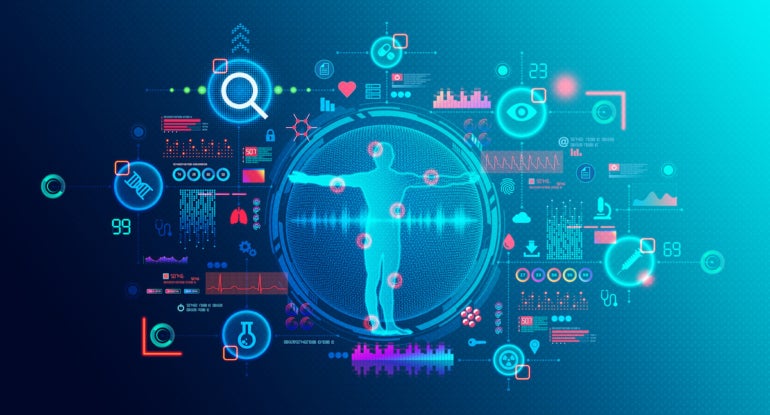
The game-changing effect of the Internet of Things is no more a hoax. It has continued to rejig the order of things in various industries, breaking expectations and nurturing fresh possibilities.
One sector that has witnessed a growing application of IoT is medicine and this trend has bred a wide range of conversations, possibilities and uncertainties. Although many things have been said about how IoT is revolutionizing the healthcare domain, there are still some gaps for other angles to these discussions.
SEE: Hiring Kit: IoT developer (TechRepublic Premium)
IoT in medicine: The 6 most important things to know
1. IoT has improved remote patient monitoring
Remote patient monitoring is one of the revolutionary trends happening in medicine. With remote patient monitoring systems, healthcare providers can use connected devices and sensors to collect and transmit health data from patients in real-time. This allows for constant monitoring of vital signs, symptoms and medical conditions, enabling healthcare providers to make informed decisions about patient care without needing in-person visits.
IoT is delivering remote patient monitoring through various devices such as wearable sensors, smart devices and smart home systems that can monitor a patient’s vital signs and other health metrics. These devices transmit the collected data to healthcare providers or a central platform where it can be analyzed and acted upon.
Some common examples of IoT devices used in remote patient monitoring include wearable fitness trackers, blood pressure monitors, smart pill dispensers and glucose monitors.
2. There are still security and privacy concerns
IoT devices in medicine collect sensitive patient data, making security and privacy a top concern. Medical data is highly sensitive and private, and the potential for unauthorized access or breaches of this data is a major concern.
In a Bloomberg report, thousands of security cameras were breached by hackers in 2021, exposing Tesla, jails and hospitals. Reporting on how porous IoT devices could be, Kaspersky recently claimed that 43% of businesses do not secure their full IoT infrastructure.
This growing level of IoT device data breaches shows that IoT devices can be vulnerable to hacking, malware and other cyber threats, which could compromise the integrity of the data being transmitted through medical IoT devices.
3. Regulatory compliance is still an issue in IoT in medicine
The application of IoT in medicine is subject to various regulations, such as HIPAA in the U.S., Data Protection Act and Common Law Duty of Confidentiality in the U.K., and European Medical Device Regulation in the EU.
These regulatory bodies ensure that medical device manufacturers follow the approved guidelines before bringing their IoT devices to the market. For instance, IoT devices for medical use in Europe must come with a Unique Device Identification. The goal is to have medical devices that are traceable to their point of origin, no matter where they are shipped worldwide.
While this is a laudable policy for Internet of Medical Things manufacturing, it’s expensive to implement the solution. Not all IoT manufacturers can play according to this regulation due to the high cost.
4. IoT in medicine is a huge market for investors
IoT in medicine could be a gold mine for tech investors in the future. According to GlobeNewswire, the global IoT healthcare market was valued at $99 billion in 2022 and is projected to reach $486 billion by 2031.
This figure shows that IoT in medicine has a promising market outlook. There are also multiple angles for investment in the IoMT market, which means that investors have many options, such as systems and software, inpatient monitoring devices and applications.
5. IoT enhances clinical research
IoT is transforming how clinical research is conducted, providing researchers with valuable insights and enabling more efficient and effective trials.
In clinical research, IoT helps to collect and transmit large amounts of patient data. IoT devices, such as wearable sensors and other smart medical devices, can gather information continuously, providing researchers with a wealth of information for analysis. This can help improve the accuracy and validity of clinical trials and provide new insights into disease progression and potential targets for treatment.
Further, IoT devices in medicine can also help increase patient compliance with treatment regimens, which is essential for the validity of clinical trials. By using wearable sensors and other devices, patients can be reminded to take their medication or attend appointments, leading to higher levels of compliance and a more accurate outcome of a drug’s effectiveness.
6. IoT increases efficiency and saves time in medicine
IoT technology can automate many routine tasks, allowing healthcare workers to focus on more critical tasks.
For instance, IoT improves supply chain management by optimizing and reducing the time and costs associated with ordering and tracking medical supplies. It can also automate appointment scheduling and reminders, reducing the time spent on manual scheduling and helping patients to stay on track with their treatment plans.
With IoT in medicine, the clinical trial process can be streamlined, reducing the time and costs associated with trial design, data collection and analysis.
Discover more about IoT with a look at how it is automating warehouse operations and the top five trends to watch in industrial IoT.


